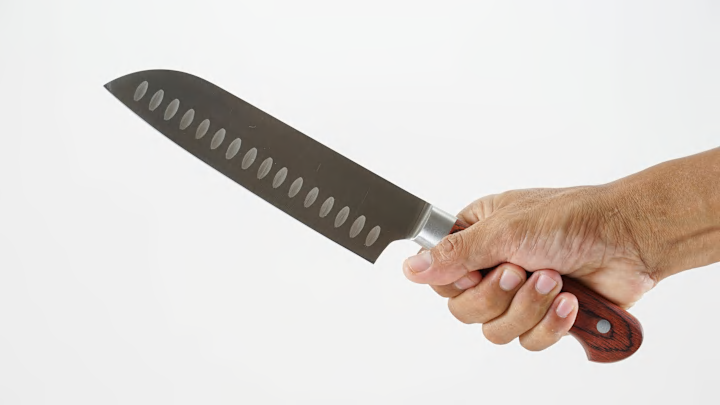Any well-stocked kitchen will have a variety of knives, from tiny blades for paring to giant, meat-slicing hatchets. You may have noticed a few knives have oval-shaped indentations in the blade that resemble dimples. Their purpose is, as you may have guessed, to make the knife function better. But how?
According to Lifehacker, the dimples (or scallops) excel at keeping food you’re slicing from sticking to the knife. When moisture-heavy ingredients are flush with the broad side of the knife, they tend to adhere to it thanks to suction. The dimples facilitate air pockets, meaning the food can’t stick very well. Result: You can scrape vegetables or other stuff off the blade more easily.
Knives with the dimples are described as having a Granton edge or kullenschliff, which is German for “cut or grind.” But they’re not exactly the same. A Granton edge blade is named after Granton Knifemakers, a UK blade company that manufactures knives with dimples that extend all the way to the edge of the blade. A kullenschliff is a knife unaffiliated with Granton that may have dimples that extend close to—but not right at—the edge.
They’re often found on Santoku knives, a Japanese style of all-purpose cutlery that also features a dull tip. But they’re not exclusive to that type of knife, and you may be able to find the indentations in other types or brands.
What is the best knife?
While the dimples are generally superior as a low-stick surface than conventional knives, they’re not stick-proof. Starchy foods like potatoes can remain persistently clingy, and you still may have to struggle for a few moments to get every last bit of green pepper off the knife and onto your prep surface.
In a recent analysis of chef’s knives, the New York Times selected the Mac MTH-80 as a top choice but cautioned the dimples weren’t a major selling point. “In our tests, the dimples were merely mildly effective—and only when cutting butternut squash,” they wrote. “Squash slices stuck to the blades of every knife we tested, but it was easier to remove the squash from our pick’s blade.”
The size of the scallop might be a factor in its effectiveness. Wired recently touted the Glestain Gyuto knife as effective thanks to enormous dimples that look cavernous compared to other types. The verdict: Food still clung to the blade, but not as heavily as it did with other knives.
Because the dimples need a heavier blade, these types of knives are usually thicker than other styles. That thickness could prompt the knife to get stuck when cutting through certain types of food. Some chefs may prefer a lighter tool.
If you opt for a dimpled knife, make sure the indentations are close to the edge. If they’re in the middle or higher, then the manufacturer is more concerned with them being decorative rather than functional. It’s also good to have the dimples on alternating spaces on both sides of the blade rather than being directly behind one another: Steel sandwiched between two dimples on either side might be thinner and weaker, making for a less structurally stable tool. If you can find one that checks off all these boxes, a good dimpled knife should be able to shave a few seconds off your prep time.
Get Answers to More Big Questions:
